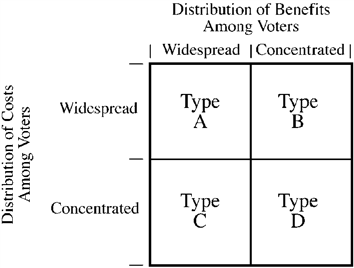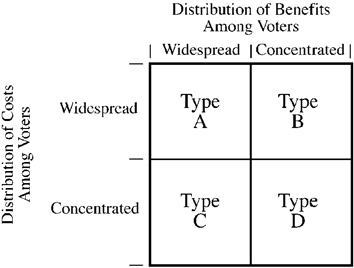A) private choice analysis.
B) public choice analysis.
C) government operations analysis.
D) policy preference analysis.
Correct Answer

verified
Correct Answer
verified
Multiple Choice
Which of the following is true of government activities under a system of representative democracy?
A) If a majority favors an activity, it must be productive.
B) If a majority opposes an activity, it must be counterproductive.
C) When voters pay in proportion to benefits received, productive activities undertaken by the government will be favored by an overwhelming majority of voters.
D) When voters pay in proportion to benefits received, productive activities will generally be defeated under a majority rule vote.
Correct Answer

verified
Correct Answer
verified
Multiple Choice
As both the budget and regulatory powers of government grow, public choice analysis indicates that individuals and groups will find it in their interest to
A) increase their efforts devoted toward market production.
B) spend less time attempting to secure redistribution through government.
C) spend more time informing themselves about political issues, so they can cast a well-informed vote.
D) spend more time rent seeking.
Correct Answer

verified
Correct Answer
verified
Multiple Choice
When the government both provides a service and covers its costs through taxation,
A) the government has a strong incentive to supply consumers with desired goods at a low cost.
B) consumers are in a weak position to either discipline the suppliers or alter the quantity or quality of the service provided.
C) the invisible hand will direct decision makers toward the most efficient level of output.
D) Consumers have strong incentive to be cost conscious.
Correct Answer

verified
Correct Answer
verified
Multiple Choice
Legislation that offers immediate and easily recognized benefits, at the expense of uncertain costs that are in the distant future (such as financing by government debt) , is often enacted even when economic inefficiency results. This can be expected because of
A) a lack of incentive for operational efficiency in the public sector.
B) market failure.
C) the special-interest effect.
D) the shortsightedness effect.
Correct Answer

verified
Correct Answer
verified
Multiple Choice
Which of the following provides the most reasonable explanation for why agricultural interests lobby for higher farm subsidies and price supports?
A) Without the farm subsidies, food shortages would result.
B) Subsidies promote the efficient use of agricultural resources.
C) Agricultural interests seek a redistribution of income favoring themselves.
D) The price support programs reduce food costs, which helps the poor.
Correct Answer

verified
Correct Answer
verified
Multiple Choice
Market allocation and the political process differ in that
A) competition is present in the market sector but not in the political sector.
B) scarcity is a constraint in the market sector but not the political sector.
C) there is a one-to-one link between payment for and receipt of a good in the market sector, but this is often not true in the political sector.
D) in the political sector, voters have a strong incentive to acquire information that will help them make better decisions, but in the market sector, consumers do not have much incentive to acquire information.
Correct Answer

verified
Correct Answer
verified
Multiple Choice
Use the figure below to answer the following question(s) .
Figure 6-1
 Figure 6-1 illustrates the four possibilities of the distribution of costs and benefits among voters for a government project. For which type would the government most likely fail to undertake many projects that would be considered efficient or productive (in other words, do too few of them relative to economic efficiency) ?
Figure 6-1 illustrates the four possibilities of the distribution of costs and benefits among voters for a government project. For which type would the government most likely fail to undertake many projects that would be considered efficient or productive (in other words, do too few of them relative to economic efficiency) ?
A) type A
B) type B
C) type C
D) type D
Correct Answer

verified
Correct Answer
verified
Multiple Choice
Use the figure below to answer the following question(s) .
Figure 6-1
 Figure 6-1 illustrates the four possibilities of the distribution of costs and benefits among voters for a government project. A tariff on imported steel to protect jobs in the domestic steel industry that raises the cost of many products for consumers would be considered which type of project?
Figure 6-1 illustrates the four possibilities of the distribution of costs and benefits among voters for a government project. A tariff on imported steel to protect jobs in the domestic steel industry that raises the cost of many products for consumers would be considered which type of project?
A) type A
B) type B
C) type C
D) type D
Correct Answer

verified
Correct Answer
verified
Multiple Choice
The rational-ignorance effect is a result of
A) externalities that lead to an excess supply of information.
B) the limited incentive of the news media to cover political campaigns.
C) the expectation of individual voters that their vote will not be decisive.
D) the lack of a college education on the part of most voters in the United States.
Correct Answer

verified
Correct Answer
verified
Multiple Choice
Which of the following is true?
A) The incentives to engage in rent-seeking activities increase with the ease with which the political process can provide personal gain at the expense of others.
B) The amount of resources devoted toward rent seeking generally has no impact on the economic prosperity of a nation.
C) Income transfers directed toward the poor constitute about half of all income transfers in the United States.
D) All of the above are correct.
Correct Answer

verified
Correct Answer
verified
Multiple Choice
Transfer payments are
A) payments made to individuals who are employed by the government.
B) payments made to individuals who provide goods and services to the government.
C) transfers of income from taxpayers to recipients who do not provide current goods and services for the payments.
D) omitted from the government expenditure figures.
Correct Answer

verified
Correct Answer
verified
Multiple Choice
People who spend more time and effort investigating the advantages and disadvantages of different automobile models when they go to purchase one than they do investigating the strengths and weaknesses of presidential candidates are saying, in effect, that
A) a good car is more important to their well-being than a good president.
B) they expect to use the information on the merits of alternative cars to greater personal advantage than they could information on the merits of alternative presidential candidates.
C) they are irrational, because the choice of a president is obviously far more important than the choice of a car.
D) they do not think it matters who is elected president.
Correct Answer

verified
Correct Answer
verified
Multiple Choice
Public choice theory assumes each voter will tend to support the political candidate who offers
A) programs with the largest benefits to society.
B) the highest potential for being a good leader in times of war.
C) programs that create the most equal distribution of income.
D) to provide the voter with the most personal benefits at the least personal cost.
Correct Answer

verified
Correct Answer
verified
Multiple Choice
Which of the following factors weakens the case for private-sector provision of goods and services relative to public-sector provision?
A) externalities
B) the rational-ignorance effect
C) the shortsightedness effect
D) well-informed consumers
Correct Answer

verified
Correct Answer
verified
Multiple Choice
According to the economic way of thinking, personal benefits and costs influence the actions of
A) consumers in the private sector but not voters in the public sector.
B) producers in the private sector but not politicians in the public sector.
C) taxpayers but not recipients of government-provided goods and services.
D) consumers, producers, voters, and politicians in both the private and the public sectors.
Correct Answer

verified
Correct Answer
verified
Multiple Choice
Scenario 6-1 The quotation below relates to the following question(s) . "The ideal policy, from the viewpoint of the state, is one with identifiable beneficiaries, each of whom is helped appreciably, at the cost of many unidentifiable persons, none of whom is hurt very much." (George Stigler, A Dialogue on the Proper Economic Role of the State ) Refer to Scenario 6-1. This statement is probably
A) incorrect because voters are well informed on a wide range of political issues.
B) incorrect because the political process dilutes the influence of special interest groups, because like other citizens, their members have only one vote.
C) correct because the well-informed voter will favor policies that cater to the views of small groups of people.
D) correct because voters who have a strong personal interest in an issue will tend to support candidates who cater to their views, whereas most other voters ignore the issue.
Correct Answer

verified
Correct Answer
verified
Multiple Choice
Public choice theory suggests that politicians will be most likely to favor redistribution of income from
A) the rich to the poor.
B) disorganized individuals to well-organized special interest groups.
C) middle-income taxpayers to both the rich and the poor.
D) well-organized business and labor groups to consumers.
Correct Answer

verified
Correct Answer
verified
Multiple Choice
Public choice analysis suggests that voters considering whether to vote for a candidate will ask,
A) "What will the candidate do that will promote the general welfare of society?"
B) "What will the candidate do that will benefit me, and how much will it cost me?"
C) "Will the candidate pursue only programs that increase economic efficiency?"
D) "What will the candidate do that will benefit everyone in the country?"
Correct Answer

verified
Correct Answer
verified
Multiple Choice
Public choice analysis
A) assumes individuals in the public sector act in their own self-interests.
B) assumes individuals seek to serve the public interest rather than their own personal interests.
C) is the study of decision making in the formation and operation of private organizations.
D) assumes the government is a corrective device that takes the necessary action to offset economic inefficiency arising from market failure.
Correct Answer

verified
Correct Answer
verified
Showing 141 - 160 of 360
Related Exams